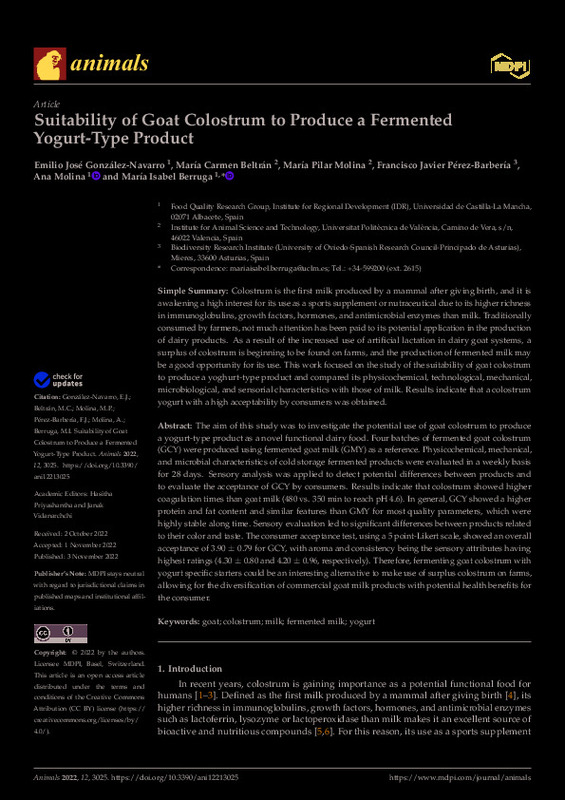JavaScript is disabled for your browser. Some features of this site may not work without it.
Buscar en RiuNet
Listar
Mi cuenta
Estadísticas
Ayuda RiuNet
Admin. UPV
Suitability of Goat Colostrum to Produce a Fermented Yogurt-Type Product
Mostrar el registro sencillo del ítem
Ficheros en el ítem
| dc.contributor.author | González-Navarro, Emilio José
|
es_ES |
| dc.contributor.author | Beltrán Martínez, Mª Carmen
|
es_ES |
| dc.contributor.author | Molina Pons, Mª Pilar
|
es_ES |
| dc.contributor.author | Pérez-Barbería, Francisco Javier
|
es_ES |
| dc.contributor.author | Molina Casanova, Ana María
|
es_ES |
| dc.contributor.author | Berruga Fernández, María Isabel
|
es_ES |
| dc.date.accessioned | 2023-06-12T18:01:30Z | |
| dc.date.available | 2023-06-12T18:01:30Z | |
| dc.date.issued | 2022-11-03 | es_ES |
| dc.identifier.uri | http://hdl.handle.net/10251/194106 | |
| dc.description.abstract | [EN] The aim of this study was to investigate the potential use of goat colostrum to produce a yogurt-type product as a novel functional dairy food. Four batches of fermented goat colostrum (GCY) were produced using fermented goat milk (GMY) as a reference. Physicochemical, mechanical, and microbial characteristics of cold storage fermented products were evaluated in a weekly basis for 28 days. Sensory analysis was applied to detect potential differences between products and to evaluate the acceptance of GCY by consumers. Results indicate that colostrum showed higher coagulation times than goat milk (480 vs. 350 min to reach pH 4.6). In general, GCY showed a higher protein and fat content and similar features than GMY for most quality parameters, which were highly stable along time. Sensory evaluation led to significant differences between products related to their color and taste. The consumer acceptance test, using a 5 point-Likert scale, showed an overall acceptance of 3.90 ± 0.79 for GCY, with aroma and consistency being the sensory attributes having highest ratings (4.30 ± 0.80 and 4.20 ± 0.96, respectively). Therefore, fermenting goat colostrum with yogurt specific starters could be an interesting alternative to make use of surplus colostrum on farms, allowing for the diversification of commercial goat milk products with potential health benefits for the consumer. | es_ES |
| dc.description.sponsorship | This research was financially supported by the "Plan Propio de Investigacion" of the University of Castilla-La Mancha (Spain). | es_ES |
| dc.language | Inglés | es_ES |
| dc.publisher | MDPI AG | es_ES |
| dc.relation.ispartof | Animals | es_ES |
| dc.rights | Reconocimiento (by) | es_ES |
| dc.subject | Goat | es_ES |
| dc.subject | Colostrum | es_ES |
| dc.subject | Milk | es_ES |
| dc.subject | Fermented milk | es_ES |
| dc.subject | Yogurt | es_ES |
| dc.subject.classification | PRODUCCION ANIMAL | es_ES |
| dc.title | Suitability of Goat Colostrum to Produce a Fermented Yogurt-Type Product | es_ES |
| dc.type | Artículo | es_ES |
| dc.identifier.doi | 10.3390/ani12213025 | es_ES |
| dc.rights.accessRights | Abierto | es_ES |
| dc.contributor.affiliation | Universitat Politècnica de València. Departamento de Ciencia Animal - Departament de Ciència Animal | es_ES |
| dc.contributor.affiliation | Universitat Politècnica de València. Escuela Técnica Superior de Ingeniería Agronómica y del Medio Natural - Escola Tècnica Superior d'Enginyeria Agronòmica i del Medi Natural | es_ES |
| dc.description.bibliographicCitation | González-Navarro, EJ.; Beltrán Martínez, MC.; Molina Pons, MP.; Pérez-Barbería, FJ.; Molina Casanova, AM.; Berruga Fernández, MI. (2022). Suitability of Goat Colostrum to Produce a Fermented Yogurt-Type Product. Animals. 12(21):1-12. https://doi.org/10.3390/ani12213025 | es_ES |
| dc.description.accrualMethod | S | es_ES |
| dc.relation.publisherversion | https://doi.org/10.3390/ani12213025 | es_ES |
| dc.description.upvformatpinicio | 1 | es_ES |
| dc.description.upvformatpfin | 12 | es_ES |
| dc.type.version | info:eu-repo/semantics/publishedVersion | es_ES |
| dc.description.volume | 12 | es_ES |
| dc.description.issue | 21 | es_ES |
| dc.identifier.eissn | 2076-2615 | es_ES |
| dc.identifier.pmid | 36359149 | es_ES |
| dc.identifier.pmcid | PMC9657146 | es_ES |
| dc.relation.pasarela | S\490236 | es_ES |
| dc.contributor.funder | Universidad de Castilla-La Mancha | es_ES |








